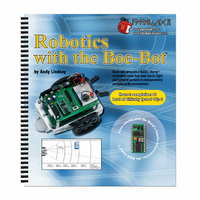28125 Parallax Inc, 28125 Datasheet - Page 241

28125
Manufacturer Part Number
28125
Description
TEXT ROBOTICS
Manufacturer
Parallax Inc
Datasheet
1.28125.pdf
(360 pages)
Specifications of 28125
Title
Robotics with the Boe-Bot
Product
Microcontroller Accessories
Lead Free Status / RoHS Status
Not applicable / Not applicable
- Current page: 241 of 360
- Download datasheet (5Mb)
SUMMARY
This chapter focused on measuring differences in light intensity and programming the
Boe-Bot to act on these differences. A pair of cadmium sulfide (CdS) photoresistors
were used to measure differences in visible light. The CdS photoresistors were first
connected to resistors to form voltage dividers, and the BASIC Stamp monitored the
voltage at the connection between the photoresistor and the fixed resistor. When this
voltage dropped below or rose above 1.4 V the input register for the I/O pin connected to
the circuit stored either a 0 or 1. The Boe-Bot was programmed to make decisions using
these binary values in a manner similar to the whiskers.
The photoresistor divider technique works so long as the right resistors are chosen and
the lighting doesn’t change. However, a much more versatile way of detecting light
levels with the BASIC Stamp is to use the CdS photoresistor in an RC circuit, charge the
capacitor, and then measure the decay time. RC stands for resistor capacitor, and the
capacitor was introduced in this chapter along with a circuit that makes it possible for the
BASIC Stamp to measure RC decay time. This is easily done with the BASIC Stamp
using the RCTIME command, which is specifically designed for measuring RC decay
and growth times.
Constants were introduced as a way to substitute meaningful names for numbers that are
used in a PBASIC program. Scaling and averaging were also introduced. Scaling was
used to set a threshold value to indicate whether or not a flashlight beam was detected. It
was also used to determine the average value of the light levels in an area based on the
two photoresistor RC time measurements. This was used to create a threshold that
automatically self-adjusted to the overall lighting conditions, eliminating the need to
change resistors when the light levels change.
Questions
1. How does the resistance of a photoresistor respond to bright and dim light?
What happens if the light levels are between bright and dim?
Watch the Boe-Bot in Action at www.parallax.com!
You can see the Boe-Bot solving Chapter 6 Projects 1 and 2 along with other Robotics video
clips in the Robo Video Gallery under the Robotics Menu at www.parallax.com.
Related parts for 28125
Image
Part Number
Description
Manufacturer
Datasheet
Request
R

Part Number:
Description:
Microcontroller Modules & Accessories DISCONTINUED BY PARALLAX
Manufacturer:
Parallax Inc

Part Number:
Description:
BOOK UNDERSTANDING SIGNALS
Manufacturer:
Parallax Inc
Datasheet:

Part Number:
Description:
COMPETITION RING FOR SUMOBOT
Manufacturer:
Parallax Inc
Datasheet:

Part Number:
Description:
TEXT INFRARED REMOTE FOR BOE-BOT
Manufacturer:
Parallax Inc
Datasheet:

Part Number:
Description:
BOARD EXPERIMENT+LCD NX-1000
Manufacturer:
Parallax Inc
Datasheet:

Part Number:
Description:
CONTROLLER 16SERVO MOTOR CONTROL
Manufacturer:
Parallax Inc
Datasheet:

Part Number:
Description:
BASIC STAMP LOGIC ANALYZER
Manufacturer:
Parallax Inc
Datasheet:

Part Number:
Description:
IC MCU 2K FLASH 50MHZ SO-18
Manufacturer:
Parallax Inc
Datasheet:














